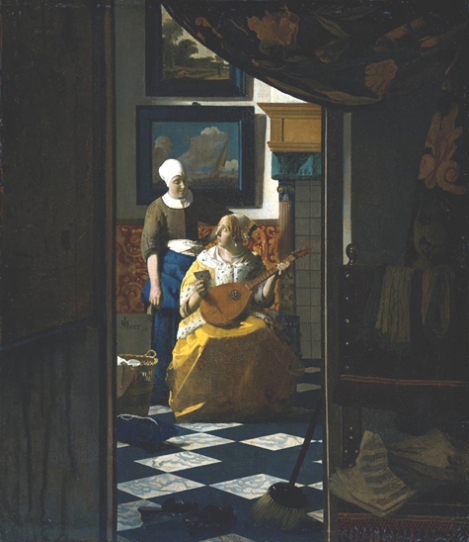
The Love Letter background
•This painting is called The love letter.
•It was painted by Johannes Vermeer in 1669.
•Actually it is exhibited in the Rijksmuseum of Amsterdam.
•The picture consists on a servant maid that hands over a letter and a young woman who is playing a lute.
Aesthtic description
•The most important feature from the picture is the shadowed doorway.
•The darkness combined with the light in the distance makes an optical illusion of spatial relief.
•The curtain in the foreground has the sense of looking at a personal scene.
•The lines on the floor try to create a three-dimensional and deep space.
Symbolic analysis
The paintings on the wall:
→ The two paintings are very significant.
→ Their composition consisted on a landscape with a man and a stormy seascape with a ship.
→ The landscape´s picture:
§ A traveler man follows the figure of a woman.
§ It shows the desire of reunion.
→ The stormy seascape picture:
The ship a solitary pilgrim.
The storm the fight of searching his love.
The love letter:
→It is a clear reflection of love.
→The musical elements help to the fact that it is a
love letter.
The slippers:
→ they are a symbol of illicit love.
• Symbolic Conclusion:
The presence of musical references, paintings and other specific elements help the mood of the picture to show its nostalgic and love view.
Final conclusion
•The light of the picture gives importance to the background.
•The chequered floor gives depth to the picture.
•Specific elements help to understand the name of the painting.
The Love Letter (Dutch: De liefdesbrief) is a 17th century painting by Johannes Vermeer. In the painting is a servant maid that hands over a letter to a young woman with a lute. The painting is part of the collection of the Rijksmuseum Amsterdam.
The tied-up curtain in the foreground creates the impression that the viewer is looking at an intensely private, personal scene. The diagonals on the chequered floor create the impression of depth and three-dimensionality.
The fact that it is a love letter that the woman has received is made clear by the fact that she is carrying a lute (more specifically, a cittern, a member of the lute/guitar family). The lute was a symbol of love – often carnal love – in the sixteenth century. This idea is further reinforced by the slippers at the very bottom of the picture. The removed slipper was another symbol of illicit love. The floor brush would appear to represent domesticity, and its placement at the side of the painting may suggest that domestic concerns have been forgotten or pushed aside.
The two paintings on the wall are also significant. The lower painting is of a stormy sea, a clear metaphor for tempestuous love. Above it is a picture of a traveller on a sandy road. This may refer to the absence of the man who is writing to the lady.
The Love Letter (Dutch: De liefdesbrief) is a 17th century painting by Johannes Vermeer. In the painting is a servant maid that hands over a letter to a young woman with a lute. The painting is part of the collection of the Rijksmuseum Amsterdam.
The tied-up curtain in the foreground creates the impression that the viewer is looking at an intensely private, personal scene. The diagonals on the chequered floor create the impression of depth and three-dimensionality.
The fact that it is a love letter that the woman has received is made clear by the fact that she is carrying a lute (more specifically, a cittern, a member of the lute/guitar family). The lute was a symbol of love – often carnal love – in the sixteenth century. This idea is further reinforced by the slippers at the very bottom of the picture. The removed slipper was another symbol of illicit love. The floor brush would appear to represent domesticity, and its placement at the side of the painting may suggest that domestic concerns have been forgotten or pushed aside.
The two paintings on the wall are also significant. The lower painting is of a stormy sea, a clear metaphor for tempestuous love. Above it is a picture of a traveller on a sandy road. This may refer to the absence of the man who is writing to the lady.